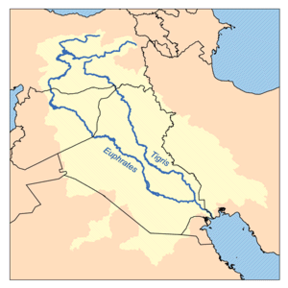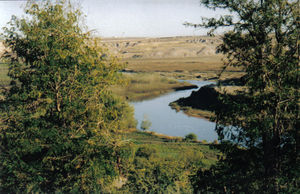Tigris
2008/9 Schools Wikipedia Selection. Related subjects: Geography of Asia
| Tigris | |
|---|---|
| Map of the Tigris-Euphrates Watershed | |
| Origin | Eastern Turkey |
| Mouth | Shatt al-Arab |
| Basin countries | Turkey, Iraq, Syria and Iran |
| Length | 1,900 km (1,150 mi) |
The Tigris is the eastern member of the two great rivers that define Mesopotamia, along with the Euphrates, which flows from the mountains of Turkey through Iraq.
Etymology
The original Sumerian name was Idigna or Idigina, probably from *id (i)gina "running water", which can be interpreted as "the swift river", contrasted to its neighbour, the Euphrates, whose leisurely pace caused it to deposit more silt and build up a higher bed than the Tigris. This form was borrowed and gave rise to Akkadian Idiqlat. Either through a Persian intermediary or directly from Akkadian, the word was adopted into Greek as Tigris ("Τίγρης" which is also Greek for "tiger"). In the Hebrew Bible, the river was called חִדֶּ֫קֶל (Ḥiddẹqel, KJV Hiddekel)
In Turkish, diş means tooth and also explains "sharpness". Pahlavi tigr means "arrow", in the same family as Old Persian tigra- "pointed" (compare tigra-xauda), Modern Persian têz "sharp". However, it does not appear that this was the original name of the river, but that it (like the Semitic forms of the name) was coined as an imitation of the indigenous Sumerian name. This is similar to the Persian name of the Euphrates, Ufratu, which does have a meaning in Persian, but is still modeled after the Sumerian name Purattu.
Another name for the Tigris, used from the time of the Persian Empire, is Arvand Rud, literally Arvand River. Today the name Arvand Rud is the Persian name for the confluence of the Euphrates and Tigris rivers which in Arabic is called Shatt al-Arab.
The name of the Tigris in languages that have been important to the region:
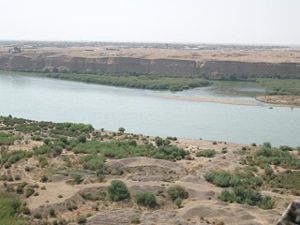
| Language | Name for Tigris |
|---|---|
| Akkadian | Idiqlat |
| Arabic | دجلة, Dijla |
| Aramaic | דיגלת , Diglath |
| Armenian | Տիգրիս, Tigris |
| Greek | ἡ Τίγρης, -ητος, hē Tígrēs, -ētos; ἡ, ὁ Τίγρις, -ιδος, hē, ho Tígris, -idos |
| Hebrew | חידקל , Ḥîddeqel |
| Hurrian | Aranzah |
| Kurdish | Dîcle |
| Persian | Old Persian:Tigrā; Middle Persian:Tigr; Modern Persian:دجله Dijle |
| Sumerian | Idigna/Idigina |
| Syriac | ܕܩܠܬ Deqlaṯ |
| Turkish | Dicle |
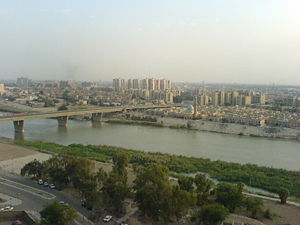
Description
The Tigris is approximately 1,900 km (1,180 miles) long, rising in the Taurus Mountains of eastern Turkey and flowing in a generally southeasterly direction until it joins the Euphrates near al-Qurnah in southern Iraq. The two rivers together form the Shatt al-Arab waterway, which empties into the Persian Gulf. The Tigris is joined by many tributaries, including the Diyala and both the Upper and Lower Zab rivers.
Baghdad, the capital of Iraq, stands on the banks of the Tigris. The port city of Basra straddles the Shatt al-Arab. In ancient times, many of the great cities of Mesopotamia stood on or near the Tigris, drawing water from it to irrigate the civilization of the Sumerians. Notable Tigris-side cities included Nineveh, Ctesiphon, and Seleucia, while the city of Lagash was irrigated by Tigris water delivered to it via a canal dug around 2400 BC. Saddam Hussein's hometown, Tikrit, is also located on the river and derives its name from it.
The Tigris has long been an important transport route in a largely desert country. It is navigable as far as Baghdad by shallow-draft vessels, but rafts are needed for transport upstream to Mosul. River trade declined in importance during the 20th century as the Basra-Baghdad-Mosul railway and roads took over much of the freight traffic.
Management and water quality
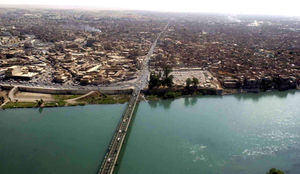
The Tigris is heavily dammed in Iraq and Turkey, to provide water for irrigating the arid and semi-desert regions bordering the river valley. Damming has also been important for averting floods in Iraq, to which the Tigris has historically been notoriously prone following snowmelt in the Turkish mountains around April. Recent Turkish damming of the river has been the subject of some controversy, both for its environmental effects within Turkey and its potential to reduce the flow of water downstream. Mosul Dam, located on the Tigris, is the largest dam in Iraq.
Coalition forces destroyed Iraq's water treatment plants during the 1990 Gulf War, affecting the water quality of the Tigris. Since the 2003 invasion of Iraq the United States Agency for International Development has refurbished, expanded and improved water and sewage treatment plants and reports significant improvement in water quality.
Religion
The Tigris appears twice in the Bible. In the Book of Genesis, the Tigris is the third of the four rivers branching off the river issuing out of the Garden of Eden. Daniel received one of his visions "when I was by that great river the Tigris".
Mythology
In Sumerian mythology, the Tigris river was created by the god Enki, who ejaculated and filled the river with flowing water.
